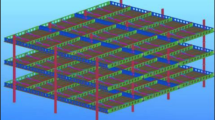Abstract
This study shows a computer-oriented design tool conceptually extracting a so-called steel-framed “Diagrid”, which has been wellknown as a specific and effective structural unit cell for mainly free-formed building frames. The goal of this study is to provide a smart design optimization task to measure the effects of variation of optimally geometrical configurations like shape and topology of the diagrid to structural engineers. Numerical applications verify how optimal solutions by using the present topology optimization design tool can evaluate promising possibility to conceptually generate practical diagrid unit cells as a trial of building related issues.
Similar content being viewed by others
References
Bendsoe, M. P. (1989). “Optimal shape design as a material distribution problem.” Structural Optimization, Vol. 1, pp. 193–202.
Bendsoe, M. P. (1995). Optimization of structural topology, Shape, and Material, Springer, Berlin, Heidelberg, New York.
Bendsøe, M. P. and Kikuchi, N. (1988). “Generating optimal topologies in structural design using homogenization method.” Comput. Meth. Appl. Mech. Engrg, Vol. 71, pp. 197–224.
Bridwell, S. G. (2005). “Swiss re building.” Architecture, Vol. 489, pp. 107–115.
Carroll, C., Cross, P., Duan, X., Gibbons, C., Ho, G., Kwok, M., Lawson, R., Lee, A., Luong, A., and McGowan, R. (2005). “CCTV Headquarters, beijing, china structural engineering design and approvals.” ARUP Journal, Vol. 40, No. 2, pp. 3–9.
Chew, M. Y. L. (2009). Construction technology for tall buildings, 3rd Edition, World Scientific.
Diaz A.R. and Kikuchi N. (1992). “Solutions to shape and topology eigenvalue optimization problems using a homogenization method.” International Journal for Numerical Methods in Engineering, Vol. 35, No. 7, pp.1487–1502.
Genduso, B. (2004). Structural redesign of a perimeter diagrid lateral system, Senior Thesis, Architectural Engineering, Penn State University.
Haug, E. J., Choi, K. K., and Komkov, V. (1986). Design sensitivity analysis of structural systems, Academic Press, Orlando, New York.
Krog, L. A. and Olhoff, N. (1999). “Optimum topology and reinforcement design of disk and plate structures with multiple stiffness and eigenfrequency objectives.” Computers and Structures, Vol. 72, No. 4, pp. 535–563.
Lee, B. K., Jeong, J. S., Fan, L. G., and Jin, T. K. (2012). “Free vibration of tapered piles embedded partially in Winkler type foundations.” KSCE Journal of Civil Engineering, KSCE, Vol. 3, No. 2, pp. 195–203.
Lee, D. K., Starossek, U., and Shin, S. M. (2010). “Optimized topology extraction of steel-framed diagrid structures for tall buildings.” International Journal of Steel Structures, Vol. 10, No. 2, pp. 157–164.
McCain, I. (2009). DiaGrid: Structural efficiency & increasing popularity, 〈www.dsg.fgg.uni-lj.si/dubaj2009/.../Diagrid%20tehnologija.pdf〉.
Nordenson G.., Riley T. (2003). Tall buildings, The Museum of Modern Art.
Pedersen, N. L. (2000). “Maximization of eigenvalues using topology optimization.” Structural Multidisciplinary Optimization, Vol. 20, No. 1, pp. 2–11.
Pope, J. E. (1997). Rule of thumb for mechanical engineers — A manual of quick, accurate solutions to everyday mechanical engineering problems, Gulf Publishing Company, Houston, Texas.
Rahimian, A. and Eilon, Y. (2006). “New York’s Hearst Tower — A restoration, an adaptive reuse and a modern steel tower rolled into one.” Structure Magazine, pp. 25–29.
Rodrigues, H. C., Guedes, J. M., and Bendsoe, M. P. (1995). “Necessary conditions for optimal-design of structures with a nonsmooth eigenvalue based criterion.” Structural Optimization, Vol. 9, No. 1, pp. 52–56.
Seyranian, A. P., Lund, E., and Olhoff, N. (1994). “Multiple eigenvalues in structural optimization problems.” Structural Optimization, Vol. 8, No. 4, pp. 207–227.
Sigmund, O. (2001). “A 99 topology optimization code written in Matlab.” Structural and Multidisciplinary Optimization, Vol. 21, No. 2, pp. 120–127.
Svanberg, K. (1987). “The method of moving asymptotes — A new method for structural optimization.” International Journal for Numerical Methods in Engineering, Vol. 24, No. 2, pp. 359–373.
Wells, M. (2005). Skyscrapers: Structure and design, Laurence King Publishing.
Youn, S. K. and Park, S. H. (1997). “A Study on the shape extraction process in the structural topology optimization using homogenization material.” Computers and Structures, Vol. 62, No. 3, pp. 527–538.
Zimmer, A. S. and Bell, G. R. (2006). John hancock center scaffold collapse, ASCE Fourth Forensic Engineering Congress.
Author information
Authors and Affiliations
Corresponding author
Rights and permissions
About this article
Cite this article
Lee, D., Lee, J., Kim, J. et al. Investigation on material layouts of structural Diagrid frames by using topology optimization. KSCE J Civ Eng 18, 549–557 (2014). https://doi.org/10.1007/s12205-014-0107-0
Received:
Revised:
Accepted:
Published:
Issue Date:
DOI: https://doi.org/10.1007/s12205-014-0107-0




